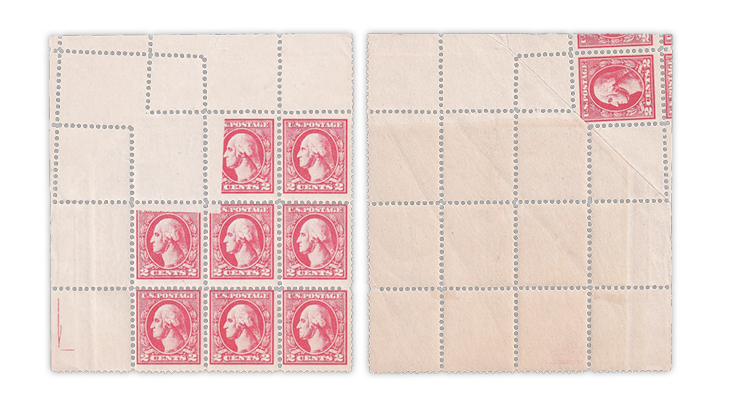US Stamps
Foldover creates dramatic color-missing error of U.S. 1920 2¢ George Washington stamp

By Charles Snee
A dramatic color-missing error of the United States 1920 2¢ carmine type V George Washington definitive stamp (Scott 527) came to light in early November.
The error is the result of a paper foldover that occurred before the stamps were printed by offset lithography, a surface printing method.
Illustrated here, front and back, is the top left margin block of nine stamps that contains the error; it is the first stamp in the top row of three. The foldover is opened (unfolded) to better show how the error occurred.
The preprinting paper fold also left the three stamps adjoining the error stamp with small parts of the design missing. Five of the nine stamps in the block are normally printed.
One stamp with an almost complete printed design can be seen on the back of the foldover along with smaller printed areas of three other stamps.
Andrew Kelley of Colorado, who collects the popular Washington-Franklin series that includes Scott 527, initially emailed Linn’s U.S. Stamp Notes columnist John M. Hotchner, an expert in the field of errors, freaks and oddities.
In his reply, which he also sent to Linn’s, Hotchner told Kelley that he thought the error was genuine. “To me this does meet the proper and technical definition of an error since the entire design is, well, not gone, but shall we say ‘elsewhere,’ ” Hotchner wrote.
Kelley told Linn’s that he found the block containing the color-missing error on eBay. “It is an amazing piece, but I couldn’t quite persuade myself to pay the asking price. When the seller offered a discount, I jumped on it,” he said.
“When I acquired the block, I regarded it as a spectacular fold-over. In my experience as a specialist in the Washington-Franklins, ‘crazy perforations’ and other varieties from post-printing foldovers are not especially scarce. However, varieties caused by pre-printing paper folds are much less common.”
In the world of stamp errors, there are two involving color: color omitted and color missing.
The Scott Specialized Catalogue of United States Stamps and Covers defines color-omitted errors as “stamps where a missing color is caused by the complete failure of the printing plate to deliver ink to the stamp paper or any other paper.” Such errors typically occur because the printing plate is not engaged on the press or an ink station runs dry during printing.
Color-missing errors are “stamps in which a color or colors were printed somewhere but do not appear on the finished stamp.”
The Scott U.S. Specialized catalog recognizes and lists four types of color-missing errors: foldover, extraneous paper, color misregistration and perforation shift. They are abbreviated FO, EP, CM and PS in their respective listings in the catalog.
A foldover blocks ink from appearing on stamp. A piece of extraneous paper can prevent the transfer of ink from the printing plate to the stamp paper. When the extraneous paper is removed, an unprinted area of stamp paper remains and shows partially or totally missing colors.
A color misregistration occurs when the printing plate is out of register. This may result in a color not appearing on the finished stamp. Finally, a perforation shift after printing may remove a color from part of the finished stamp’s design.
Following a careful review, Scott catalog editor-in-chief Jay Bigalke determined that the new color-missing error will appear in the U.S. listings in Vol. 1 of the 2022 Scott Standard Postage Stamp Catalogue that will be published in April 2021. The error also will be listed in the 2022 edition of the Scott U.S. Specialized catalog scheduled for publication in October 2021.
As for Kelley, he was quite pleased to learn that his discovery will be listed in the Scott catalog.
“I am thrilled to add such a nice showpiece to my collection,” he said. “But I am also reminded of what a wonderful group of friends and experts share our hobby.”
Connect with Linn’s Stamp News:
Sign up for our newsletter
Like us on Facebook
Follow us on Twitter
MORE RELATED ARTICLES
Headlines
-
US Stamps
Oct 7, 2024, 3 PMMcMurtrie dismissed as APS education director following Sept. 21 arrest
-
US Stamps
Oct 7, 2024, 12 PMVasiliauskas named president of Mystic Stamp Co.
-
US Stamps
Oct 6, 2024, 5 PMApgar souvenir card available
-
US Stamps
Oct 6, 2024, 4 PMFirst Continental Congress and U.N. stamps receive Scott catalog numbers








